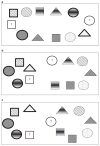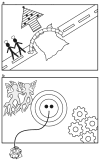Multiple family groups for adult cancer survivors and their families: a 1-day workshop model
- PMID: 21884077
- PMCID: PMC4532272
- DOI: 10.1111/j.1545-5300.2011.01359.x
Multiple family groups for adult cancer survivors and their families: a 1-day workshop model
Abstract
With marked advances in early detection and aggressive multimodality treatment, many adult cancers are now associated with good prognoses for disease-free survival. A burgeoning literature examining posttreatment quality-of-life issues has highlighted the numerous challenges experienced by patients and families in the aftermath of cancer treatment, further underscoring a need for new family-based psychosocial support interventions for cancer survivors and their families. This paper describes the clinical protocol for one such intervention, a 1-day "workshop" version of a multiple family group (MFG) for head and neck cancer survivors and their families. Data are reported from our experiences in running five 1-day workshops. Families uniformly reported that they were highly satisfied with their MFG participation, leading us to conclude that the abbreviated 1-day MFG model we are advocating is a promising family-focused support intervention for cancer survivors and their families.
2011 © FPI, Inc.
Figures

Family membership connoted by varied within-symbol patterns (e.g., the “Polka-Dot” family; the “Diagonal-Line” family; the “Cross-Hatched” family).
Illness role is connoted by either single (noncancer) or double (cancer patient) outlining.
Family role connoted by geometric shape (e.g., circles for wives; squares for husbands; triangles for children).

Similar articles
-
Interest in and barriers to participation in multiple family groups among head and neck cancer survivors and their primary family caregivers.Fam Process. 2004 Jun;43(2):195-208. doi: 10.1111/j.1545-5300.2004.04302005.x. Fam Process. 2004. PMID: 15603503
-
Worry in Head and Neck Cancer Caregivers: The Role of Survivor Factors, Care-Related Stressors, and Loneliness in Predicting Fear of Recurrence.Nurs Res. 2017 Jul/Aug;66(4):295-303. doi: 10.1097/NNR.0000000000000223. Nurs Res. 2017. PMID: 28654567
-
Fear of Cancer Recurrence and Its Impacts on Quality of Life in Family Caregivers of Patients With Head and Neck Cancers.J Nurs Res. 2016 Sep;24(3):240-8. doi: 10.1097/jnr.0000000000000169. J Nurs Res. 2016. PMID: 27509212
-
Quality of life in long-term survivors of adult-onset cancers.J Natl Cancer Inst. 1998 May 6;90(9):656-67. doi: 10.1093/jnci/90.9.656. J Natl Cancer Inst. 1998. PMID: 9586662 Review.
-
Long-term issues and supportive care needs of adolescent and young adult childhood brain tumour survivors and their caregivers: A systematic review.Psychooncology. 2019 Mar;28(3):477-487. doi: 10.1002/pon.4989. Epub 2019 Feb 1. Psychooncology. 2019. PMID: 30657618
Cited by
-
Psychosocial Interventions to Improve Wellbeing in Teenage and Young Adult Post-Treatment Survivors of Childhood Cancer: A Systematic Review.Psychooncology. 2025 Feb;34(2):e70081. doi: 10.1002/pon.70081. Psychooncology. 2025. PMID: 39921358 Free PMC article.
-
Are family-oriented interventions in Portuguese genetics services a remote possibility? Professionals' views on a multifamily intervention for cancer susceptibility families.J Community Genet. 2012 Oct;3(4):311-8. doi: 10.1007/s12687-012-0079-z. Epub 2012 Feb 8. J Community Genet. 2012. PMID: 22314708 Free PMC article.
-
Phenomenological study: the experiences of patients with nasopharyngeal cancer after undergoing chemoradiation.BMC Nurs. 2019 Aug 16;18(Suppl 1):29. doi: 10.1186/s12912-019-0356-9. eCollection 2019. BMC Nurs. 2019. PMID: 31427891 Free PMC article.
-
Psychological factors associated with head and neck cancer treatment and survivorship: evidence and opportunities for behavioral medicine.J Consult Clin Psychol. 2013 Apr;81(2):299-317. doi: 10.1037/a0029940. Epub 2012 Sep 10. J Consult Clin Psychol. 2013. PMID: 22963591 Free PMC article. Review.
-
Adapting a whole health model to home-based primary care: Bridging person-driven priorities with veteran and family-centered geriatric care.Fam Syst Health. 2021 Jun;39(2):374-393. doi: 10.1037/fsh0000613. Fam Syst Health. 2021. PMID: 34410781 Free PMC article.
References
-
- American Cancer Society (ACS) Cancer facts & figures 2009. Atlanta: American Cancer Society; 2009.
-
- Alfano C, Rowland J. Recovery issues in cancer survivorship: A new challenge for supportive care. Cancer Journal. 2006;127:432–443. - PubMed
-
- Asen E. Multiple family therapy: An overview. Journal of Family Therapy. 2002;24:3–16.
-
- Baider L, Cooper C, Kaplan De-Nour A. Cancer and the family. 2. Chichester, UK: John Wiley & Sons Ltd; 2000.
-
- Baider L, Walch N, Perry S, Kaplan De-Nour A. Cancer in married couples: Higher or lower distress? Journal of Psychosomatic Research. 1998;45:239–248. - PubMed
Publication types
MeSH terms
Grants and funding
LinkOut - more resources
Full Text Sources
Medical

